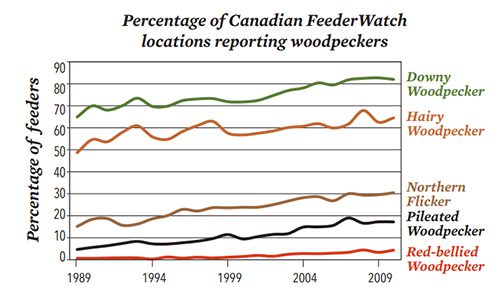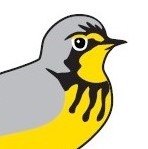By Ellen Jakubowski, Communications Specialist, Birds Canada

Red-bellied Woodpecker Photo: Mike Fisher
April is here! That means warmer temperatures, spring migrants, and the beckoning call of the great outdoors. But before we get swept away by all of that, let’s take a moment to acknowledge another rite of spring: the conclusion of Project FeederWatch season.
This season of Project FeederWatch was especially noteworthy, as it marked 30 years of monitoring feeder birds across North America. The history of the program, now more than 20,000 participants strong, can be traced back to Canada and the Ontario Bird Feeder Survey initiated by Dr. Erica Dunn in the mid-1970s. It began as a way to boost membership at Long Point Bird Observatory. However, after successfully engaging more than 500 participants over 10 years, Dunn realized the potential of this project for monitoring bird populations on a much larger scale. So, in 1986, she reached out to the Cornell Lab of Ornithology, and Project FeederWatch as we know it – covering both Canada and the U.S. – came into being as a continent-wide joint program of Birds Canada and the Cornell Lab.
With so many Citizen Scientists counting winter birds across North America, Project FeederWatch provides a substantial pool of data, useful for detecting population trends. For example, FeederWatchers have tracked falling numbers of Evening Grosbeaks across much of this species’ historic range (Figure 1); this formerly-common bird was recently designated as “Special Concern” in Canada because of these declines.

Figure 1. Percent of feeders visited by Evening Grosbeak in the northwest (blue), northeast (orange), and central (green) regions of North America since 1989. Source: feederwatch.org
FeederWatchers have also detected upward trends in some species. Robins have been spotted earlier and at a greater percentage of FeederWatch sites in recent years compared to the 1980s and ’90s (see Figure 2). An uptick in several woodpecker species in Canada, corresponding with results from the North American Breeding Bird Survey, has also been noted (see Figure 3). While Project FeederWatch results can’t tell us why these changes are happening, they help expose long-term patterns to be investigated more deeply.
The collection of count data amassed by FeederWatchers is a valuable resource to scientists studying bird populations. Project FeederWatch data have informed many studies and scientific articles.
Why has Project FeederWatch been so successful? Counting feeder birds is fun and easy for birders of all skill levels. It’s also convenient to do all winter, whatever the weather. Advancements in technology have made data processing more efficient, providing participants with more immediate and detailed reports on results, as well as fascinating ways to explore data. Technology has also expanded the range of insights that can be gleaned from datasets, making it easier for scientists to explore relationships between bird abundance and other factors, such as climate or land cover.
Without a doubt, the biggest key to success for Project FeederWatch has been its tens of thousands of dedicated participants. Birds Canada would like to thank you for volunteering your time to count birds this winter. We hope you enjoy reading about this season’s results in the upcoming spring issue of BirdWatch Canada. If you’d like to contribute to the continuing success of Project FeederWatch, you can find out more and sign up to participate in the 2017-18 season on our website.



